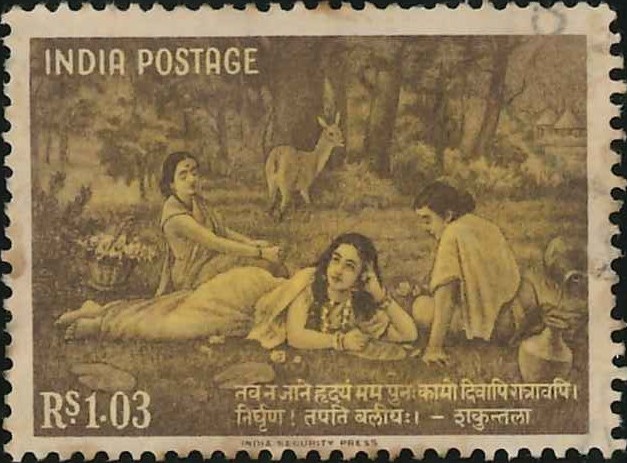
India on Kalidasa
Complete set of 2 nos of commemorative postage stamps on Kālidāsa, an Indian Sanskrit writer and dramatist, court poet of Samrat Vikramaditya during Gupta Empire :
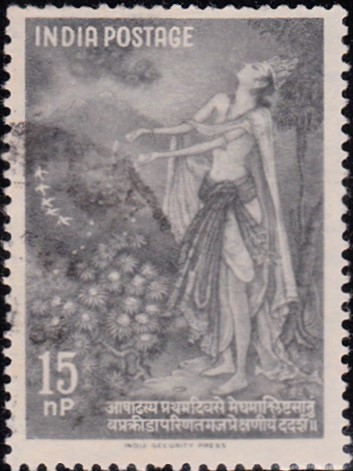
 Issued by India
Issued by India
Issued on Jun 22, 1960
Issued for : It is for all these reasons that Kālidāsa‘s influence over his contemporaries and his successors has been profound. In fact, such has been his hold on the Sanskrit literary world that once, when the poets were being counted, Kālidāsa, being the first, occupied the last finger, but none could come upto even the second place and the ring finger has consequently remained nameless, anāmikā as it is referred to in Sanskrit. On Indian poetry in particular and on Indian art in general, the stamp of his genius and inspiration has been enduring. The excellence and the quality of his works have created a widening circle of admirers abroad, and if the Posts and Telegraphs Department, departing from normal tradition and policy, has decided to commemorate this illustrious poet-dramatist with the issue of two stamps unrelated to any conventional anniversary but related to a date in one of his own works, it is as a humble tribute to the great and honoured place which Kālidāsa occupies among the world’s most illustrious authors and which his works have achieved in the libraries and literatures of the world.
Design : The two stamps illustrating scenes from his great works viz., the Meghadūta and the Śākuntala are being issued on the first day of Āsādha (June 22, 1960), the day on which the Yaksa of the Meghadūta, while sojourning in Rāmagiri, appealed to the Cloud to carry his message to his beloved in Alakā on Mount Kailash.
The picturization is based, in the first case, on a painting by Professor Radha Charan Bagchi of Kala Bhavan, Santiniketan, and, in the second, on a painting by the late Raja Ravi Varma celebrated in this country for his portrayals of figures and scenes from classical and mythological life and lore. Incidentally, this was the very first painting done by the Raja on Indian mythology in 1878. The designs of the two stamps have been executed by the staff artists of the India Security Press – P. B. Chitnis and K. M. Dhar.
The scene from the Śākuntala depicts the incident of her writing a love-letter to her beloved Duś yanta in the midst of the sylvan beauty of the hermitage of her adopted father, the sage Kanva. The scene from the Meghadūta represents the Yaksa, pleading with the Cloud to convey his message of love and pathos to his beloved in far-off Alakā.
The stamps bear as theme the following verses out of the two works that they seek to represent :–
आषाढस्य प्रथमदिवसे मेघमाश्लिष्ट सानु
वप्रक्रीडापरिणतगजप्रेक्षणीयं ददर्श।। – Meghadūta I. 2.
तब ना जाने हृदयं मम पुनः कामो दिवापि रात्रावापि ।
निर्घृण ! तपति बलियः । – Abhijnāna-Śākuntala III. 13.
Select extracts of Kālidāsa‘s works are also appended in this brochure to bring out the various qualities and characteristics of his works and art. They are by no means a substitute for a study of the original but are intended only to provide a small window to the wide vista of his works and art. – (V. Shankar, Director-General, Posts and Telegraphs)
The cover of this brochure bears an imprint of the beautiful terracotta medallion found at Bhita Excavations in the year 1872. Measuring 3″ in diameter, it carries a scene from Kālidāsa‘s Śākuntala, in which King Duś yanta with his charioteer is being entreated not to kill the antelope which has he fled for refuge to Kanva‘s hermitage. The verse corresponding to this scene is reproduced on the cover page and an English translation appears below.
Why should his tender form expire,
As blossoms perish in the fire ?
How could that gentle life endure
The deadly arrow, sharp and sure ?
– Abhijnāna-Śākuntala I. 10.
(Translation by Arthur W. Ryder).
Type : Stamp, Postal Used
Colour :
15 nP. – Grey
Rs. 1.03 – Yellow and Dark Brown
Denomination : 15 nP. and Rs. 1.03
Size : 3.91 x 2.90 cms.
Perforation : 13
Watermark : All-over multiple ‘Lion Capital of Asoka‘
Number printed :
15 nP. – 30 million
Rs. 1.03 – 15 million
Set : 35 stamps per issue sheet
Printing Process : Photogravure
About :
- Kālidāsa, the foremost poet and dramatist in Sanskrit literature, is a treasured and invaluable part of India‘s heritage, pre-eminent in a most glorious chapter of its past. This star of matchless brilliance on India’s literary firmament shone with splendour in times which must have produced a galaxy of talent. Whether we accept the earliest period (the last century before Christ) or the latest (the fourth century after Christ), during which probably he flourished, there can scarcely be any doubt that that period was one of great patronage of art and literature, of leisure and prosperity, and of valour and greatness.
- Little is known of Kālidāsa‘s life either in history or in his works. In these he reveals the Indian world around him but gives few glimpses of himself. It was, therefore, inevitable that legend and tradition should have endowed him with an origin which enhanced the merit of his subsequent accomplishments and his art with a divine inspiration and stimulus. It is beyond dispute, however, that whatever his origin and whatever his learning, he was an accomplished devotee of the fine arts, particularly poetry and song, dance and drama; was a seasoned traveller and had thus gained a good knowledge of the geography of his country; was well versed in contemporary laws and the philosophical systems, religious principles, traditions and ritual practices. He had the painter’s eye for realism and beauty, the scientist’s precision of observation and description, the householder’s love of peaceful and settled life, the worldly-wise man’s sense of human values, the devotee’s love of the divine and the religious, and the master craftsman’s use of the supernatural to serve a mundane ethical purpose.
- It is this versatility of his genius and essentially human approach to his themes and characters that endows his personality and works with a universality which places him among the foremost literary figures of the world – Homer, Plato, Sophocles, Virgil, Shakespeare and Milton. Whether he dealt with an epic theme as in the Raghuvamśa, or described the beauties of nature as in the Rtusamhāra or portrayed mythological scenes and characters as in the Kumārasambhava or dramatised human characters as in the Śākuntala or turned to a pure lyrical and imaginative subject as in the Meghadūta, Kālidāsa‘s appeal is essentially one of rich human experiences and ideals. It has been said of Shakespeare that he had no heroes but only heroines; Kālidāsa in a sense has neither heroes nor heroines; his characters live through the pages of his works as human beings with their human virtues and foibles. Even the religious figures and supernatural beings appear to us in humanized garbs, displaying either the perfection of human attributes or the translation of the “desirable” in human beings to a divine plane.
- In a life so rich in human experiences, in works so high in excellence and attainments and in art so great in accomplishment, it is not easy to choose representative works for purposes of epitomisation. To contain a big canvas of varied art in small dimensions is difficult enough in the normal course; in the case of Kālidāsa the task is rendered even more difficult because of the vast field of life that he has taken in his artistic stride. Kālidāsa is essentially the product of his time; whether we regard it as the period of Vikramāditya of Ujjain, the founder of the Vikrama era, or as the golden age of the Gupta dynasty during the reign of Chandragupta Vikramāditya, the hero of many a battle, great administrator and rare patron of fine arts – the age of Kālidāsa was one of those rare periods of history in which life appears to find its fulfilment in different channels of human endeavour.
- The extant works which by common consent bear the unmistakable signs of his authorship are seven in number and comprise the following :–
- (i) Abhijnāna-Śākuntala – a drama dealing with the love and marriage of Duś yanta, the King and Śākuntala, a child of nature bringing joy and beauty to the hermitage of a sage. The theme is taken from the great epic – The Mahābhārata.
- (ii) Vikramorvaśīya – a drama dealing with the love and marriage of Purūravas and Urvaśī.
- (iii) Mālavikāgnimitra – a drama dealing with the love of Mālavikā and Agnimitra.
- (iv) Raghuvamśa – an epic poem describing the history, reigns and lives of the kings of the Solar race which included Rāma, the hero of The Rāmāyana.
- (v) Kumārasambhava – an epic poem dealing with an entirely religious theme, the marriage of Śiva and Pārvatī and the birth of their son Kumāra.
- (vi) Meghadūta or The Cloud Messenger – describing the journey of a Cloud carrying the message of an exiled Yaksa to his beloved, separated from him.
- (vii) Rtusamhāra – a descriptive account of the six seasons with their variety, beauty and colour.
- Of these the most widely known, read and appreciated is the Śākuntala, first translated into English by Sir William Jones in 1789 and now adorning the libraries of almost all the languages of the world. It is this play which brought forth from Goethe the following tribute :“Wouldst thou the young year’s blossoms and the fruits of its decline,
And all by which the soul is charmed, enraptured, feasted, fed,
Wouldst thou the earth and heaven itself in one sole name combine?
I name thee, O Śākuntala, and all at once is said.“ - The next best-known work of the Poet is the Meghadūta, a lyrical, imaginative masterpiece rooted in the pathos and passion of separated and pinning love and placed in the midst of the vast geographical panorama stretching from the plains of Narmada and Tapti to the snow ranges of the Himālayas – “the abode of Gods”, which, judging from his raptures over the mountain in the Kumārasambhava, were “the measuring rod of the world”. Kālidāsa‘s love of nature and eye for beauty of natural scenery find their full expression in all his plays and poems and nowhere so superbly as in the description of the seasons in the Rtusamhāra, of the journey of the Cloud through different territories in the Meghadūta and of the rivers, mountains, animals, forests and trees in the Kumārasambhava, Raghuvamśa and Śākuntala. His interpretation and ideals of life and his analysis of human moods and emotions are presented in his three dramas and two epic poems with mastery and richness combined with practical idealism which only sympathetic imagination, varied experience and balanced judgement can produce.
- पृच्छन्ती वा मधुरवचनां सारिकां पत्ज़रस्थं
कच्चिदृर्तुः स्मरसि रसिके त्वं हि तस्य प्रियति ।— मेघदुते (उत्तरमेघे) २२Or asks the caged, sweetly-singing Starling
“Do you remember, dear Lord? You were his darling”
— Meghadūta II. 22. (Translation by Arthur W. Ryder). - वागर्थाबिब संपृक्तौ वागर्थप्रतिपत्तये ।
जगतः पितरो बन्दे पार्वतीपरमेशरो ॥— रघुवंशे १-१God Śiva and his mountain bride
Like Word and meaning unified,
The World’s great parents, I beseech
To join fit meaning to my speech.
— Raghuvamśa I. 1. (Translation by Arthur W. Ryder). - द्रुमाः सपुष्पाः सलिलं सपद्मं
स्त्रियः सकामाः पवनः सुगन्धिः ।
सुखाः प्रदोषा दिवसाश्च रम्याः
सर्वं प्रिये चारुतरं वसन्ते ॥— ऋतुसंहारे ६-२Their blossom – burden weights the trees;
The winds in fragrance move;
The lakes are bright with Lotuses;
The woman bright with love;
The days are soft, the evenings clear
And charming, everything
That moves and lives and blossoms, dear,
Is sweeter in the Spring.
— Rtusamhāra VI. 2. (Translation by Arthur W. Ryder). - तन्वी श्यामा शिखरिदशना पक्वबिम्बाधरोष्ठी
मध्ये क्षामा चकितहरिणीप्रेक्षणा निम्ननाभिः ।
श्रोणीभारादलसगमना स्तोकनम्रा स्तनाम्या
या तत्र स्याधुवतिविषये सृष्टिराधेव धातुः ॥— मेघदुते (उत्तरमेघे) १९The supremest woman from God‘s workshop gone –
Young, slender; little teeth and red, red lips,
Slight waist and gentle eyes of timid fawn,
An idly graceful movement, generous hips,
Fair bosom into which the sloping shoulder slips.
— Meghadūta II. 19. (Translation by Arthur W. Ryder). - अस्त्युत्तरस्यां दिशि देवतात्मा हिमालयो नाम नगाधिराजः ।
पूर्वापरौ तोयनिधी वगाह्म स्थितः पृथिव्या इव मानदण्डः ॥— कुमारसम्भवे १-१God of distant north, the Snowy Range
O’er other mountains towers imperially;
Earth’s measuring-rod, being great and free from change,
Sinks to the eastern and the western sea.
— Kumārasambhava I. 1. (Translation by Arthur W. Ryder). - गृहिणी सचिवः सखी मित्रः प्रियशिष्या ललिते कलाविधो ।
करुणाविमुखेन मृत्युना हरता त्वां वद किं न मे हुतम ॥— रघुवंशे ८-६७You were my comrade gay, my home, my treasure,
You were my bosom’s friend, in all things true,
My best-loved pupil in the arts of pleasure :
Stern death took all I had in taking you.
— Raghuvamśa VIII. 67. (Translation by Arthur W. Ryder). - शरीरसादादसमग्रभुषणा
मुखेन सालक्ष्यत लोध्रपाण्डुना ।
तनुप्रकाशेन विचेयतारका
प्रभातकल्पा शशिनेब शर्बरी ॥— रघुवंशे ३-२Weary at Dawn with fewer Jewel stars
The expecting queen looked but the Night;
And her face pale as a lodhra flower
Matched the moon of feeble light.
— Raghuvamśa III. 2. (Translation by S. B. Velankar). - सशीकराम्भोधरमत्तकुञ्जर-
स्तडिप्तताकोशनिशब्दमर्दलः ।
समागतो राजवदुद्यतद्युति-
र्घनागमः कामिजनप्रियः प्रिये ॥— ऋतुसंहारे २-१The rain advances like a King
In awful majesty;
Hear, dearest, how his thunders ring
Like royal drums, and see
His lightning – banners wave; a cloud
For elephant he rides,
And finds his welcome from the crowd
of lovers and of brides.
— Rtusamhāra II. 1. (Translation by Arthur W. Ryder). - अनातूरोत्कण्ठितयोः प्रसिध्यता समागमेनापि रतिर्न मां प्रति ।
परस्परप्राप्तिनिराशयोर्वरं शरीरनाशोहपी समानुरागयोः ॥— मालबिकाग्निमित्रे ३-१५“I do not approve of the union, even if successfully brought about, of two lovers, one of whom is ardent, and the other indifferent; it is better that an equally enamoured pair should even pine away hopeless of mutual happiness.”
— Mālavikāgnimitra III. 15. (Translation by C. H. Tawney).
- तन्वी मेघजलार्द्रपल्लवतया धौताधरेवाक्षुभिः
शून्येवाभरणैः स्वकालविरहाद्दिक्षान्तपुष्पोदगमा ।
चिन्तामौनमिवास्थिता मधुलिहां शब्दैर्बिना लक्ष्यते ।
चण्डी मामवधुय पादपतितं जातानुतापेव सा ॥— विक्रमोर्वशीये ४-३८What means this strange emotion, as I gaze
Upon this vine? No blossoms deck its boughs;
Nipped by the falling rains, like briny tears,
That wash the ruddy freshness from the lips,
The buds have perished, and the mournful shrub
All unadorned appears to pine in absence;
No bees regale her with their songs; silent
And sad, she lonely shows the image
Of my repentent love, who now laments
Her causeless indignation.
— Vikramorvaśīya IV. 38. (Translation by H. H. Wilson). - आलक्ष्य दन्तमुकुलाननिमित्तहासै-
रव्यक्तवर्णरमणीयवचः प्रवृत्तीन ।
अङ्कश्रयप्रणयिनस्तनयान वहन्तो
धन्यास्तदङ्गरजसा मलिनीभवन्ती ॥— अभिज्ञानशाकुन्तले ७-१७They show their little buds of teeth
In peals of causeless laughter;
They hide their trustful heads beneath
Your heart. And stumbling after
Come sweet, unmeaning sounds that sing
To you. The father warms
And loves the very dirt they bring
Upon their little forms.
— Abhijnāna-Śākuntala VII. 17. (Translation by Arthur W. Ryder). - प्रवर्ततां प्रकृतिहिताय पार्थिवः
सरस्वती श्रुतिमहती महीयताम ।
समापि च क्षपयतू नीललोहितः
पुनर्भवं परिगणशक्तिरात्मभूः ॥— अभिज्ञानशाकुन्तले ७-३४May Kingship benefit the land,
And wisdom grow in scholars’ band;
May Śiva see my faith on earth
And make me free of all rebirth.
— Abhijnāna-Śākuntala VII. 34. (Translation by Arthur W. Ryder). - सरसिजमनुबिद्धं शैवलेनापि रम्यं
मलिनमपि हिमांशोर्लक्ष्म लक्ष्मीं तनोति ।हयमधिकमनोजा वल्कलेनापि तन्वी
किमिव हि मधुराणां मण्डनं नाकृतीनाम ॥— अभिज्ञानशाकुन्तले १-१७
The meanest vesture glows
On beauty that enchants:
The lotus lovelier shows
Amid dull water-plants;The moon in added splendour
Shines for its spot of dark;
Yet more the maiden slender
Charms in her dress of bark.
— Abhijnāna-Śākuntala I. 17. (Translation by Arthur W. Ryder). - रम्याणि वीक्ष्य मधुरांश्च निशम्य शब्दान
पर्युत्सुकीभवति यत्सुखितोहपि जन्तुः ।
तच्चेतसा स्मरति नूनमबोधपूर्व
भावस्थिराणि जननान्तरसौहदानि ॥— अभिज्ञानशाकुन्तले ५-२In face of sweet presentment
Or harmonies of sound,
Man e’ver forgets contentment,
By wishful longings bound.
There must be recollections
Of things not seen on earth,
Deep nature’s predilections,
Loves earlier than birth.— Abhijnāna-Śākuntala V. 2. (Translation by Arthur W. Ryder).


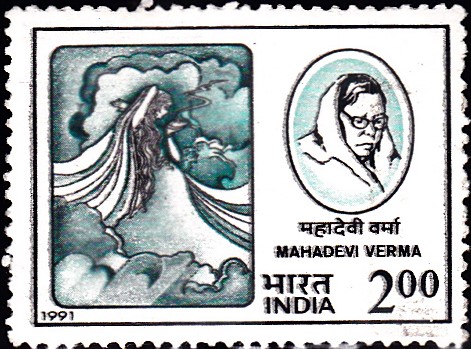
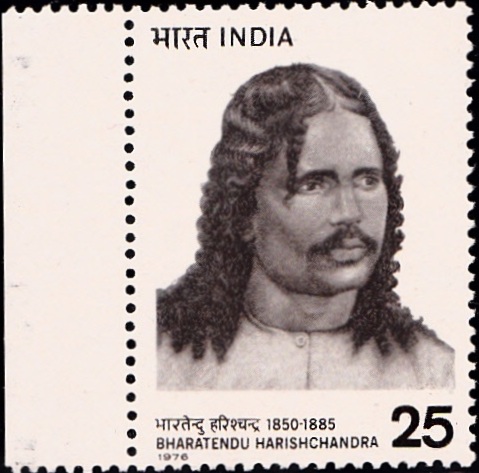
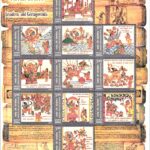
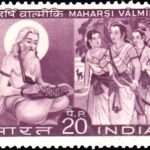
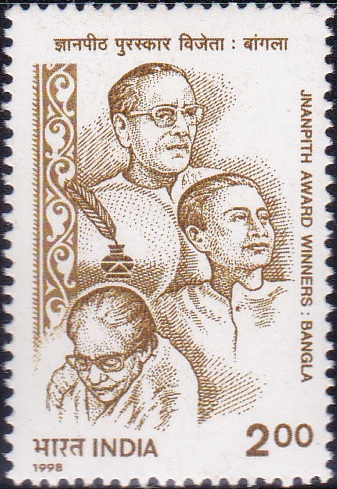
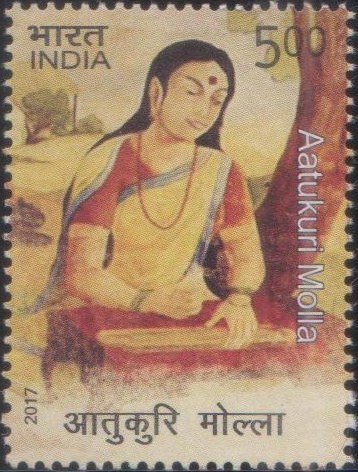
[…] Vadha‘, but such a masterpiece of literature that his name is taken alongside ‘Kalidas‘ and […]
[…] Vasant, Greeshm, Varsha, Sharad, Hemant and Shishir. The six seasons of India were described in Kalidasa’s ‘Ritusamhara’ where each season was celebrated in the language of romantic love. This […]
[…] Valley Civilization running through the Gupta period up to the Mauryan periods. The great poet Kalidas, makes detailed reference to the use of fragrances by the Protagonist of his plays. In 1469, a […]
[…] chosen for this purpose is titled “Abhisarika” and purports to illustrate a verse in Kalidasa‘s ‘Ritu Samhara.’ Although the painting is one of the earliest attempts on the […]